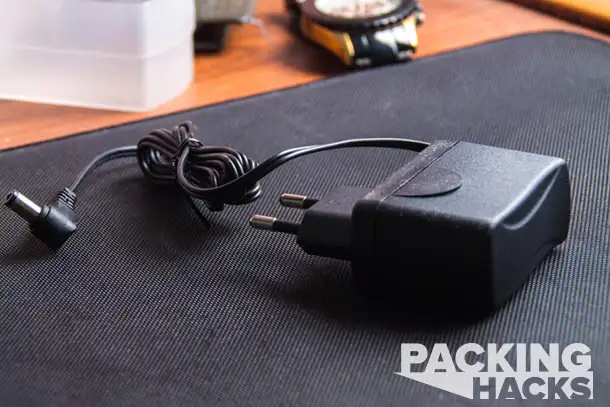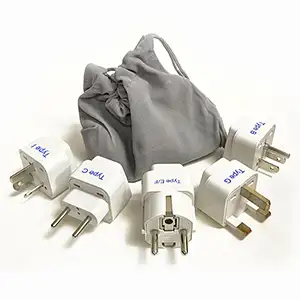
Packing Hacks is a 31-part series devoted to helping you become an expert packer! Each installment offers advice on how to get organized, pack smarter, save on bag fees, and eliminate packing stress. New to Packing Hacks? Start at the beginning.
Yesterday we covered organizing and securing all your travel gadgets, and today we’re switching gears to something more technical: how to travel with adapters and chargers.
You’ll learn:
√ The differences between adapters and converters
√ How to know which one you need
√ Which ones to buy
Let’s start with the basics: What exactly is the difference between an adapter and a converter?
An adapter changes the shape of your plug, not the electrical voltage. This allows you to plug appliances into wall outlets in countries that have different-shaped plugs. Here is a handy chart that you can consult to see which outlet designs are used in different countries.
A converter changes the voltage of your electronic device. In America, the standard voltage is 120 V. However, many other countries run on different voltages. For example, if you are traveling to England, you will need a converter to run your appliance on the 230 V system. This chart lists the voltages of every country in the world—consult it before you travel.
Before you run out and buy a converter, there’s a very important piece of information you need to know. The vast majority of modern appliances are dual-voltage, meaning they automatically convert to run on other voltage systems. Most smartphones, tablets, and other gadgets are dual-voltage, and if you use a converter on something that is already dual-voltage, you can damage your appliance.
How do you know if your device is dual-voltage? You’ll need to read its power-supply label, which is usually found printed on the back of a gadget, on the plug, or in the instruction manual. If it says something similar to “INPUT AC 120 VAC 60 Hz 200 W,” then your gadget is single-voltage and can only be used on 120 V. If you want to use it elsewhere, you’ll need a converter. If you see something like “INPUT AC 120/240 V 50—60 Hz 1300 W,” then your device is dual-voltage, and you can safely use it for voltages anywhere between 120 V and 240 V. If you’re going somewhere on the lower end of the spectrum, like Japan, where they use 100 V, you should use a converter designed for that range.
While most modern appliances are dual-voltage, older appliances and ones that use a significant amount of power (such as hair dryers) are often single-voltage, so always check before you use them abroad.
Power converters are generally bulkier and heavier than adapters (which makes sense, as they are actually changing electricity). Remember that you will always need to use an adapter with a converter, but you won’t always need to use a converter with an adapter.
Since power converters take up so much space on their own, you’ll want to buy one that comes with a built-in plug adapter. The Travel Smart by Conair is a great multiuse item, as it converts electricity and has built-in adapters for the U.K. and Europe. Plus, it has a built-in surge protector to keep your devices safe from electrical spikes. It can also be used as an adapter only, if you don’t want to buy another adapter for your dual-voltage appliances.
If you don’t need a power converter, there are plenty of adapters to choose from. Most are small and lightweight, making them easy to pack. If you’re packing lots of devices (like a camera, smartphone, and tablet), you should invest in a couple of adapters so that you can charge all of your electronics at once. A two-pack of U.S.-to-U.K. adapters will cost you less than two dollars online.
If you travel a lot, invest in a universal adapter, which lets you slide out different plug formations so that you can use the adapter in outlets in any country. If you shop around, you can usually find one for less than $10 online (this one also comes with a surge protector).
If you prefer to travel as light as possible, get a worldwide plug adapter set, which allows you to take only the adapters you need.
Be sure to buy your converter and adapter before you leave. In a foreign country, it can be hard to find one that is designed to convert your American plug/voltage into a foreign electricity/plug, rather than the other way around. Also, the converters and adapters found at airport shops are usually highly marked up, whereas you can get both for much cheaper online if you buy before you go.
Up next: Day 20: In-Flight Products for a Happy, Healthy, Comfortable Flight.
We hand-pick everything we recommend and select items through testing and reviews. Some products are sent to us free of charge with no incentive to offer a favorable review. We offer our unbiased opinions and do not accept compensation to review products. All items are in stock and prices are accurate at the time of publication. If you buy something through our links, we may earn a commission.
Related
Top Fares From
Today's Top Travel Deals
Brought to you by ShermansTravel
Kenya: 14-Night Tour, Incl. Tanzania &...
smarTours
 vacation
$7125+
vacation
$7125+
7-Night Caribbean Round-Trip Cruise From Orlando:...
Norwegian Cruise Line
 cruise
$739+
cruise
$739+
Ohio: Daily Car Rentals from Cincinnati
85OFF.com
 Car Rental
$19+
Car Rental
$19+




